The Roles of Leaders and Managers in Unilever's Operational Management
VerifiedAdded on 2021/01/02
|29
|4777
|214
Report
AI Summary
This report provides a comprehensive analysis of the roles of leaders and managers in operational management, using Unilever as a case study. It begins by defining and differentiating between leaders and managers, comparing their roles and characteristics. The report explores various leadership theories, including situational, systems, and chaos theories, as well as transformational and transactional leadership approaches. It examines how leaders and managers handle situations such as organizational restructuring, the introduction of new business models, and disasters/emergencies. The report highlights the importance of operational management in achieving business objectives and analyzes factors within the business environment that impact operational management and decision-making. The analysis includes an examination of Unilever's practices, providing insights into how the company applies these concepts in its operations. The report concludes with an evaluation of operations management and factors affecting the wider business environment.
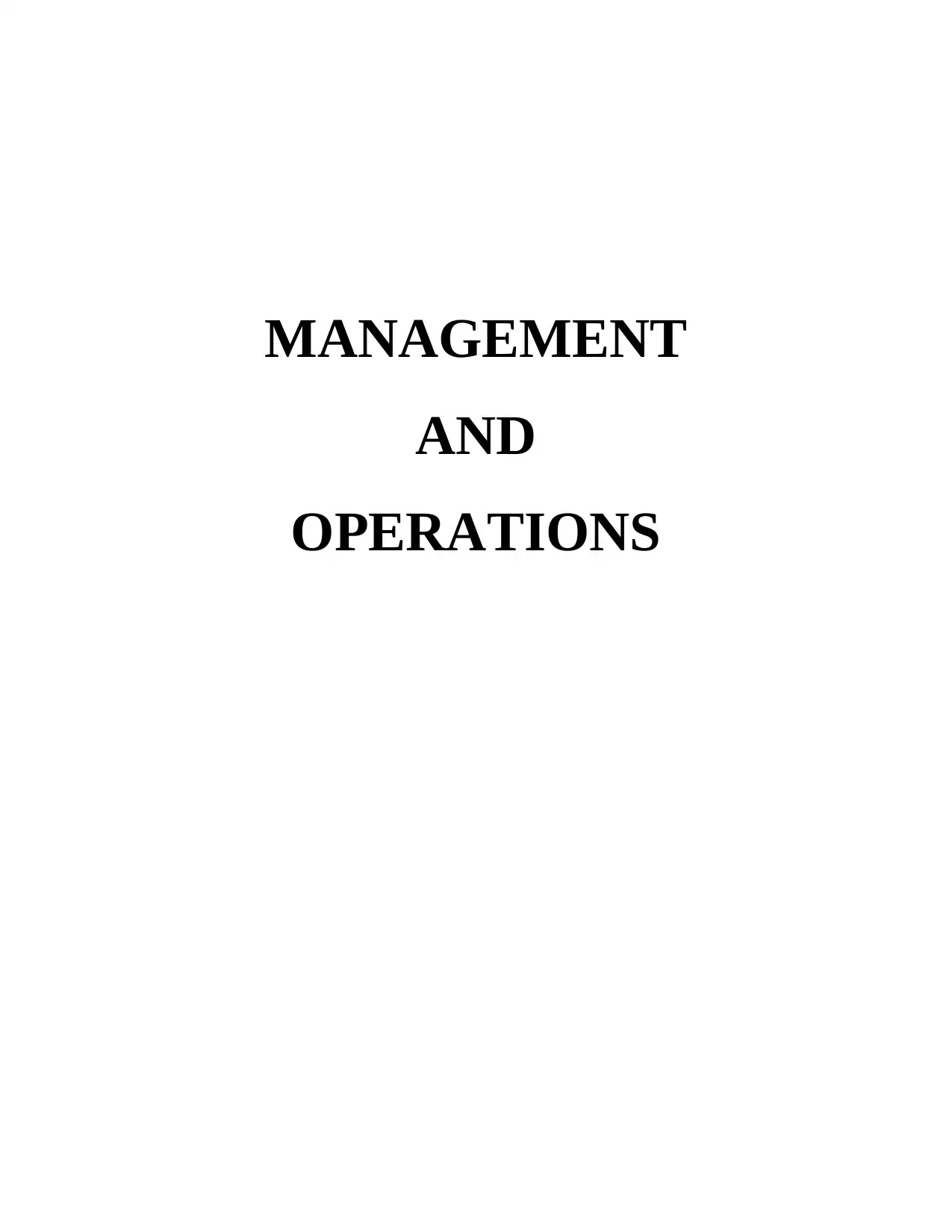
MANAGEMENT
AND
OPERATIONS
AND
OPERATIONS
Paraphrase This Document
Need a fresh take? Get an instant paraphrase of this document with our AI Paraphraser
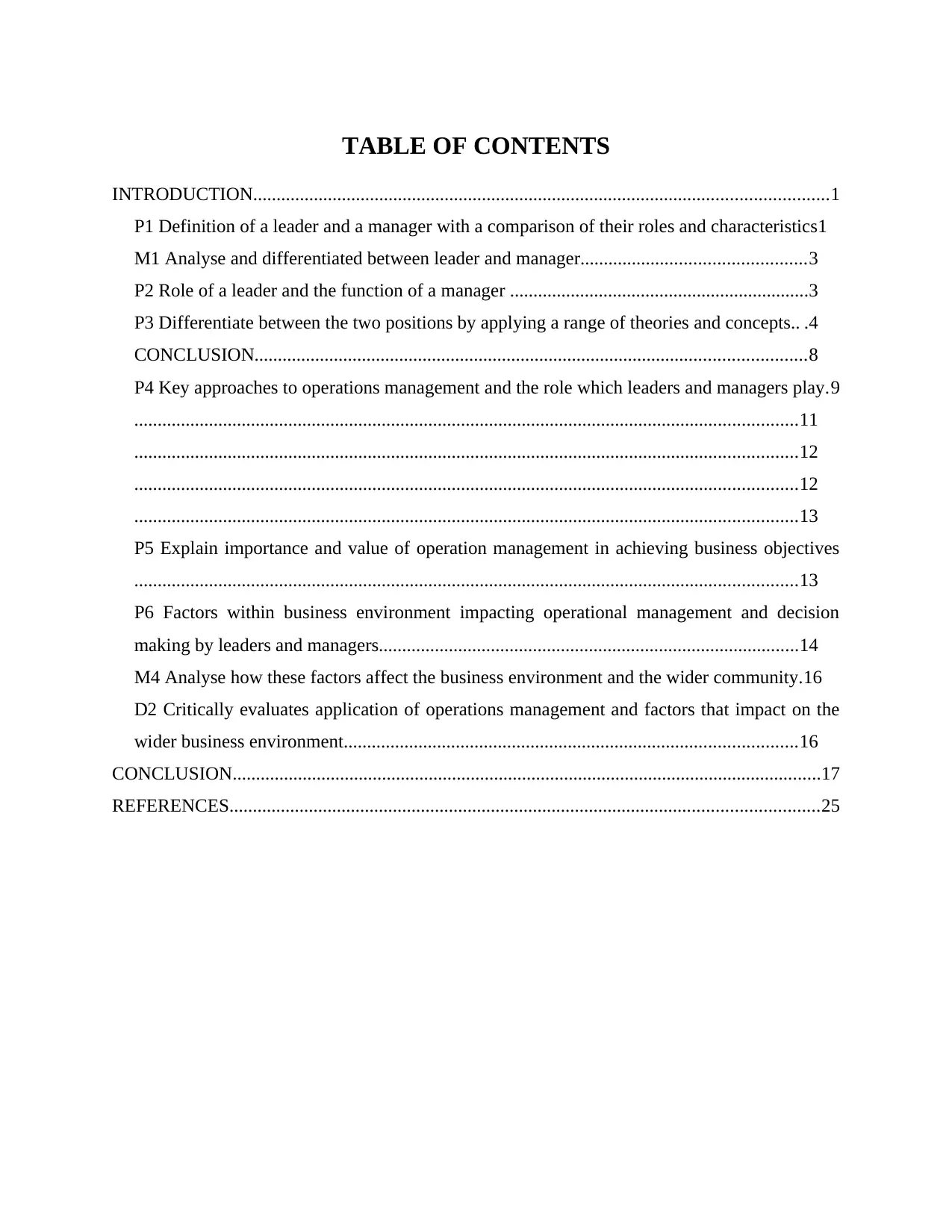
TABLE OF CONTENTS
INTRODUCTION...........................................................................................................................1
P1 Definition of a leader and a manager with a comparison of their roles and characteristics1
M1 Analyse and differentiated between leader and manager................................................3
P2 Role of a leader and the function of a manager ................................................................3
P3 Differentiate between the two positions by applying a range of theories and concepts.. .4
CONCLUSION......................................................................................................................8
P4 Key approaches to operations management and the role which leaders and managers play.9
..............................................................................................................................................11
..............................................................................................................................................12
..............................................................................................................................................12
..............................................................................................................................................13
P5 Explain importance and value of operation management in achieving business objectives
..............................................................................................................................................13
P6 Factors within business environment impacting operational management and decision
making by leaders and managers..........................................................................................14
M4 Analyse how these factors affect the business environment and the wider community.16
D2 Critically evaluates application of operations management and factors that impact on the
wider business environment.................................................................................................16
CONCLUSION..............................................................................................................................17
REFERENCES..............................................................................................................................25
INTRODUCTION...........................................................................................................................1
P1 Definition of a leader and a manager with a comparison of their roles and characteristics1
M1 Analyse and differentiated between leader and manager................................................3
P2 Role of a leader and the function of a manager ................................................................3
P3 Differentiate between the two positions by applying a range of theories and concepts.. .4
CONCLUSION......................................................................................................................8
P4 Key approaches to operations management and the role which leaders and managers play.9
..............................................................................................................................................11
..............................................................................................................................................12
..............................................................................................................................................12
..............................................................................................................................................13
P5 Explain importance and value of operation management in achieving business objectives
..............................................................................................................................................13
P6 Factors within business environment impacting operational management and decision
making by leaders and managers..........................................................................................14
M4 Analyse how these factors affect the business environment and the wider community.16
D2 Critically evaluates application of operations management and factors that impact on the
wider business environment.................................................................................................16
CONCLUSION..............................................................................................................................17
REFERENCES..............................................................................................................................25
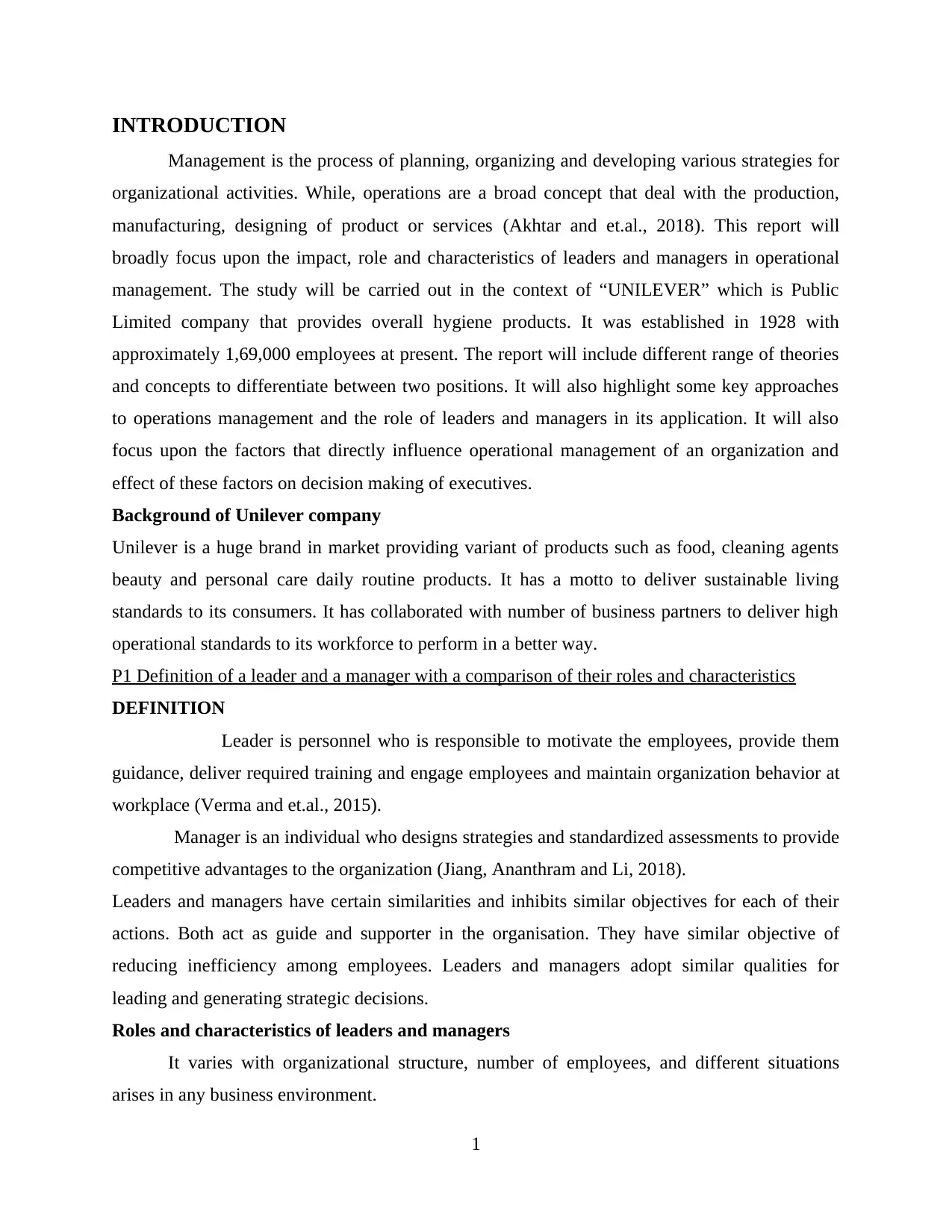
INTRODUCTION
Management is the process of planning, organizing and developing various strategies for
organizational activities. While, operations are a broad concept that deal with the production,
manufacturing, designing of product or services (Akhtar and et.al., 2018). This report will
broadly focus upon the impact, role and characteristics of leaders and managers in operational
management. The study will be carried out in the context of “UNILEVER” which is Public
Limited company that provides overall hygiene products. It was established in 1928 with
approximately 1,69,000 employees at present. The report will include different range of theories
and concepts to differentiate between two positions. It will also highlight some key approaches
to operations management and the role of leaders and managers in its application. It will also
focus upon the factors that directly influence operational management of an organization and
effect of these factors on decision making of executives.
Background of Unilever company
Unilever is a huge brand in market providing variant of products such as food, cleaning agents
beauty and personal care daily routine products. It has a motto to deliver sustainable living
standards to its consumers. It has collaborated with number of business partners to deliver high
operational standards to its workforce to perform in a better way.
P1 Definition of a leader and a manager with a comparison of their roles and characteristics
DEFINITION
Leader is personnel who is responsible to motivate the employees, provide them
guidance, deliver required training and engage employees and maintain organization behavior at
workplace (Verma and et.al., 2015).
Manager is an individual who designs strategies and standardized assessments to provide
competitive advantages to the organization (Jiang, Ananthram and Li, 2018).
Leaders and managers have certain similarities and inhibits similar objectives for each of their
actions. Both act as guide and supporter in the organisation. They have similar objective of
reducing inefficiency among employees. Leaders and managers adopt similar qualities for
leading and generating strategic decisions.
Roles and characteristics of leaders and managers
It varies with organizational structure, number of employees, and different situations
arises in any business environment.
1
Management is the process of planning, organizing and developing various strategies for
organizational activities. While, operations are a broad concept that deal with the production,
manufacturing, designing of product or services (Akhtar and et.al., 2018). This report will
broadly focus upon the impact, role and characteristics of leaders and managers in operational
management. The study will be carried out in the context of “UNILEVER” which is Public
Limited company that provides overall hygiene products. It was established in 1928 with
approximately 1,69,000 employees at present. The report will include different range of theories
and concepts to differentiate between two positions. It will also highlight some key approaches
to operations management and the role of leaders and managers in its application. It will also
focus upon the factors that directly influence operational management of an organization and
effect of these factors on decision making of executives.
Background of Unilever company
Unilever is a huge brand in market providing variant of products such as food, cleaning agents
beauty and personal care daily routine products. It has a motto to deliver sustainable living
standards to its consumers. It has collaborated with number of business partners to deliver high
operational standards to its workforce to perform in a better way.
P1 Definition of a leader and a manager with a comparison of their roles and characteristics
DEFINITION
Leader is personnel who is responsible to motivate the employees, provide them
guidance, deliver required training and engage employees and maintain organization behavior at
workplace (Verma and et.al., 2015).
Manager is an individual who designs strategies and standardized assessments to provide
competitive advantages to the organization (Jiang, Ananthram and Li, 2018).
Leaders and managers have certain similarities and inhibits similar objectives for each of their
actions. Both act as guide and supporter in the organisation. They have similar objective of
reducing inefficiency among employees. Leaders and managers adopt similar qualities for
leading and generating strategic decisions.
Roles and characteristics of leaders and managers
It varies with organizational structure, number of employees, and different situations
arises in any business environment.
1
⊘ This is a preview!⊘
Do you want full access?
Subscribe today to unlock all pages.

Trusted by 1+ million students worldwide
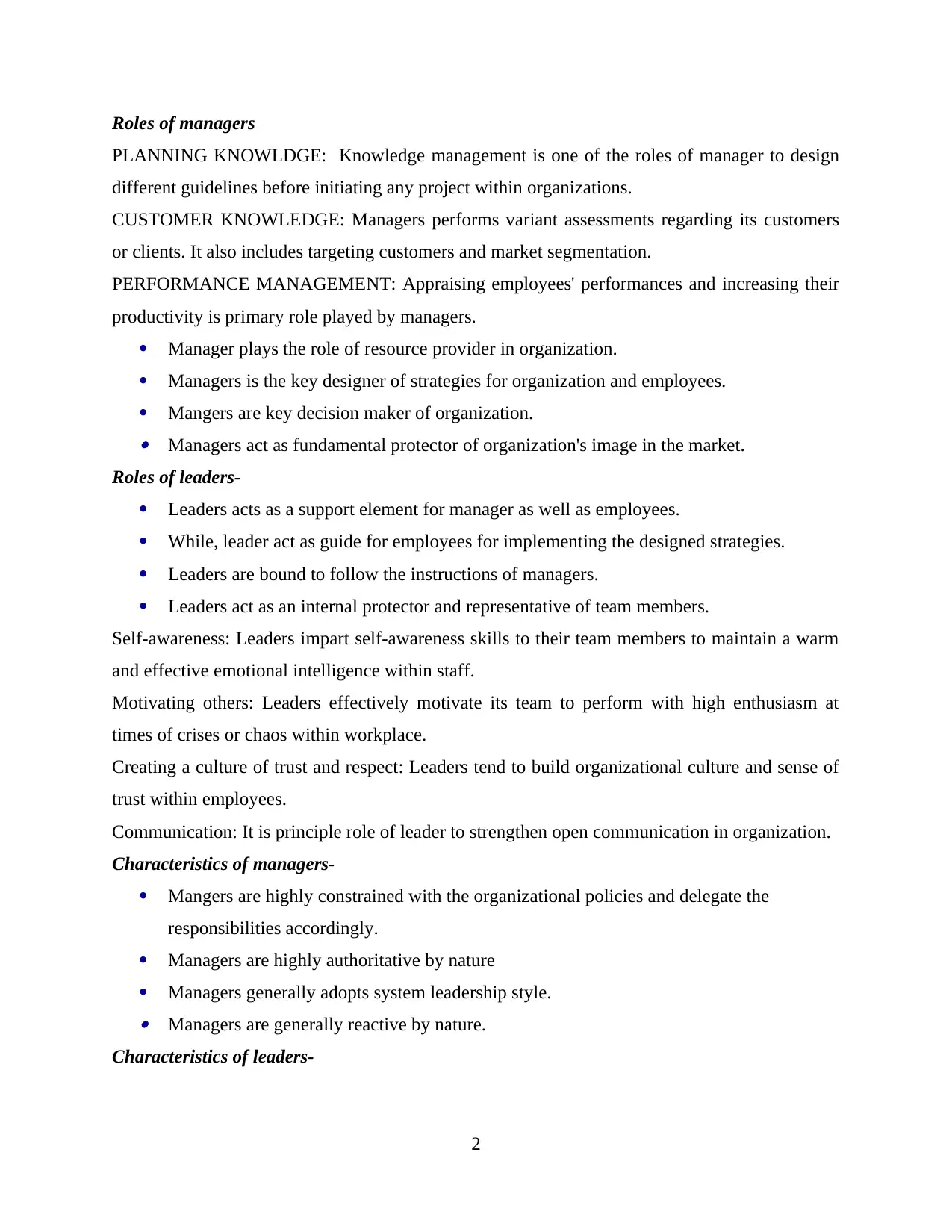
Roles of managers
PLANNING KNOWLDGE: Knowledge management is one of the roles of manager to design
different guidelines before initiating any project within organizations.
CUSTOMER KNOWLEDGE: Managers performs variant assessments regarding its customers
or clients. It also includes targeting customers and market segmentation.
PERFORMANCE MANAGEMENT: Appraising employees' performances and increasing their
productivity is primary role played by managers.
Manager plays the role of resource provider in organization.
Managers is the key designer of strategies for organization and employees.
Mangers are key decision maker of organization. Managers act as fundamental protector of organization's image in the market.
Roles of leaders-
Leaders acts as a support element for manager as well as employees.
While, leader act as guide for employees for implementing the designed strategies.
Leaders are bound to follow the instructions of managers.
Leaders act as an internal protector and representative of team members.
Self-awareness: Leaders impart self-awareness skills to their team members to maintain a warm
and effective emotional intelligence within staff.
Motivating others: Leaders effectively motivate its team to perform with high enthusiasm at
times of crises or chaos within workplace.
Creating a culture of trust and respect: Leaders tend to build organizational culture and sense of
trust within employees.
Communication: It is principle role of leader to strengthen open communication in organization.
Characteristics of managers-
Mangers are highly constrained with the organizational policies and delegate the
responsibilities accordingly.
Managers are highly authoritative by nature
Managers generally adopts system leadership style. Managers are generally reactive by nature.
Characteristics of leaders-
2
PLANNING KNOWLDGE: Knowledge management is one of the roles of manager to design
different guidelines before initiating any project within organizations.
CUSTOMER KNOWLEDGE: Managers performs variant assessments regarding its customers
or clients. It also includes targeting customers and market segmentation.
PERFORMANCE MANAGEMENT: Appraising employees' performances and increasing their
productivity is primary role played by managers.
Manager plays the role of resource provider in organization.
Managers is the key designer of strategies for organization and employees.
Mangers are key decision maker of organization. Managers act as fundamental protector of organization's image in the market.
Roles of leaders-
Leaders acts as a support element for manager as well as employees.
While, leader act as guide for employees for implementing the designed strategies.
Leaders are bound to follow the instructions of managers.
Leaders act as an internal protector and representative of team members.
Self-awareness: Leaders impart self-awareness skills to their team members to maintain a warm
and effective emotional intelligence within staff.
Motivating others: Leaders effectively motivate its team to perform with high enthusiasm at
times of crises or chaos within workplace.
Creating a culture of trust and respect: Leaders tend to build organizational culture and sense of
trust within employees.
Communication: It is principle role of leader to strengthen open communication in organization.
Characteristics of managers-
Mangers are highly constrained with the organizational policies and delegate the
responsibilities accordingly.
Managers are highly authoritative by nature
Managers generally adopts system leadership style. Managers are generally reactive by nature.
Characteristics of leaders-
2
Paraphrase This Document
Need a fresh take? Get an instant paraphrase of this document with our AI Paraphraser
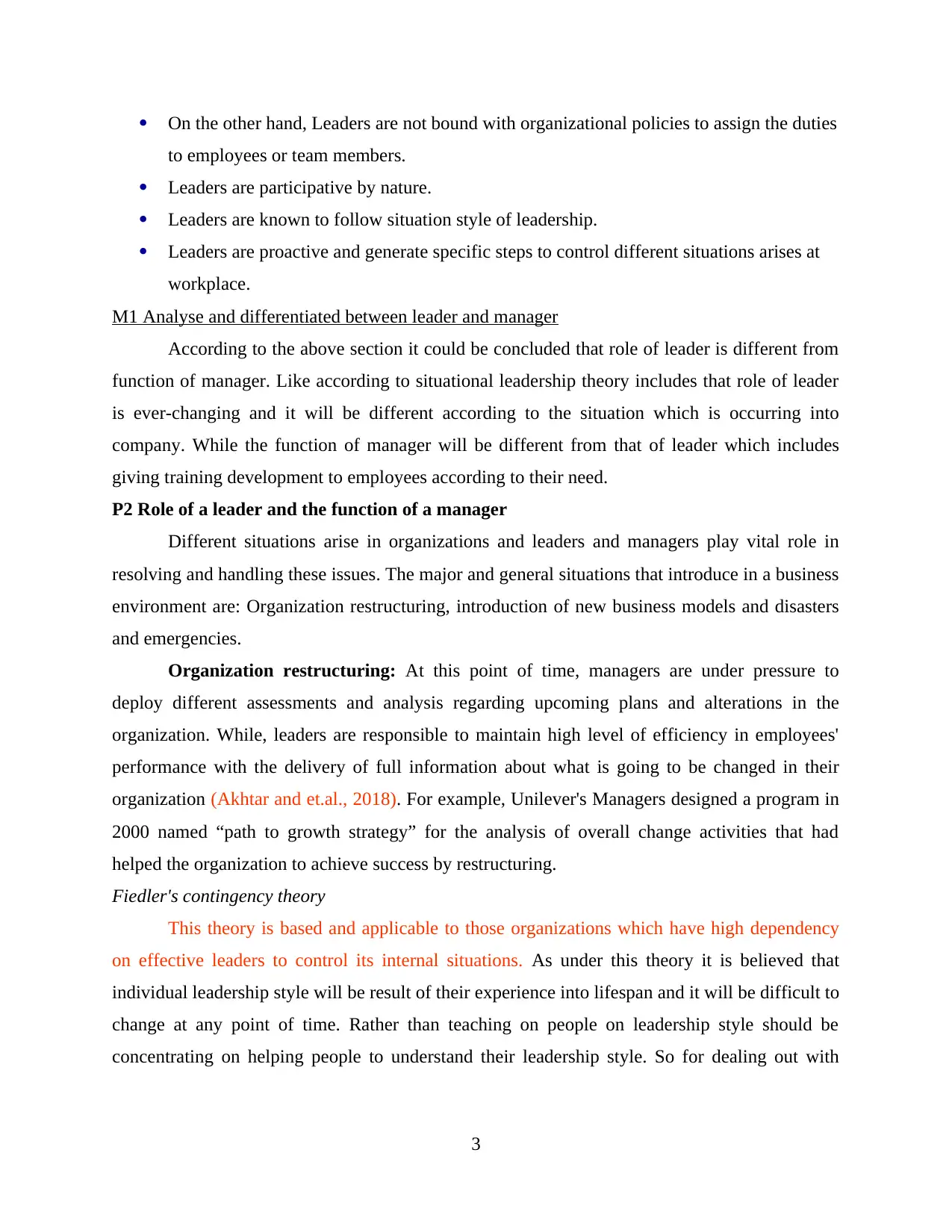
On the other hand, Leaders are not bound with organizational policies to assign the duties
to employees or team members.
Leaders are participative by nature.
Leaders are known to follow situation style of leadership.
Leaders are proactive and generate specific steps to control different situations arises at
workplace.
M1 Analyse and differentiated between leader and manager
According to the above section it could be concluded that role of leader is different from
function of manager. Like according to situational leadership theory includes that role of leader
is ever-changing and it will be different according to the situation which is occurring into
company. While the function of manager will be different from that of leader which includes
giving training development to employees according to their need.
P2 Role of a leader and the function of a manager
Different situations arise in organizations and leaders and managers play vital role in
resolving and handling these issues. The major and general situations that introduce in a business
environment are: Organization restructuring, introduction of new business models and disasters
and emergencies.
Organization restructuring: At this point of time, managers are under pressure to
deploy different assessments and analysis regarding upcoming plans and alterations in the
organization. While, leaders are responsible to maintain high level of efficiency in employees'
performance with the delivery of full information about what is going to be changed in their
organization (Akhtar and et.al., 2018). For example, Unilever's Managers designed a program in
2000 named “path to growth strategy” for the analysis of overall change activities that had
helped the organization to achieve success by restructuring.
Fiedler's contingency theory
This theory is based and applicable to those organizations which have high dependency
on effective leaders to control its internal situations. As under this theory it is believed that
individual leadership style will be result of their experience into lifespan and it will be difficult to
change at any point of time. Rather than teaching on people on leadership style should be
concentrating on helping people to understand their leadership style. So for dealing out with
3
to employees or team members.
Leaders are participative by nature.
Leaders are known to follow situation style of leadership.
Leaders are proactive and generate specific steps to control different situations arises at
workplace.
M1 Analyse and differentiated between leader and manager
According to the above section it could be concluded that role of leader is different from
function of manager. Like according to situational leadership theory includes that role of leader
is ever-changing and it will be different according to the situation which is occurring into
company. While the function of manager will be different from that of leader which includes
giving training development to employees according to their need.
P2 Role of a leader and the function of a manager
Different situations arise in organizations and leaders and managers play vital role in
resolving and handling these issues. The major and general situations that introduce in a business
environment are: Organization restructuring, introduction of new business models and disasters
and emergencies.
Organization restructuring: At this point of time, managers are under pressure to
deploy different assessments and analysis regarding upcoming plans and alterations in the
organization. While, leaders are responsible to maintain high level of efficiency in employees'
performance with the delivery of full information about what is going to be changed in their
organization (Akhtar and et.al., 2018). For example, Unilever's Managers designed a program in
2000 named “path to growth strategy” for the analysis of overall change activities that had
helped the organization to achieve success by restructuring.
Fiedler's contingency theory
This theory is based and applicable to those organizations which have high dependency
on effective leaders to control its internal situations. As under this theory it is believed that
individual leadership style will be result of their experience into lifespan and it will be difficult to
change at any point of time. Rather than teaching on people on leadership style should be
concentrating on helping people to understand their leadership style. So for dealing out with
3
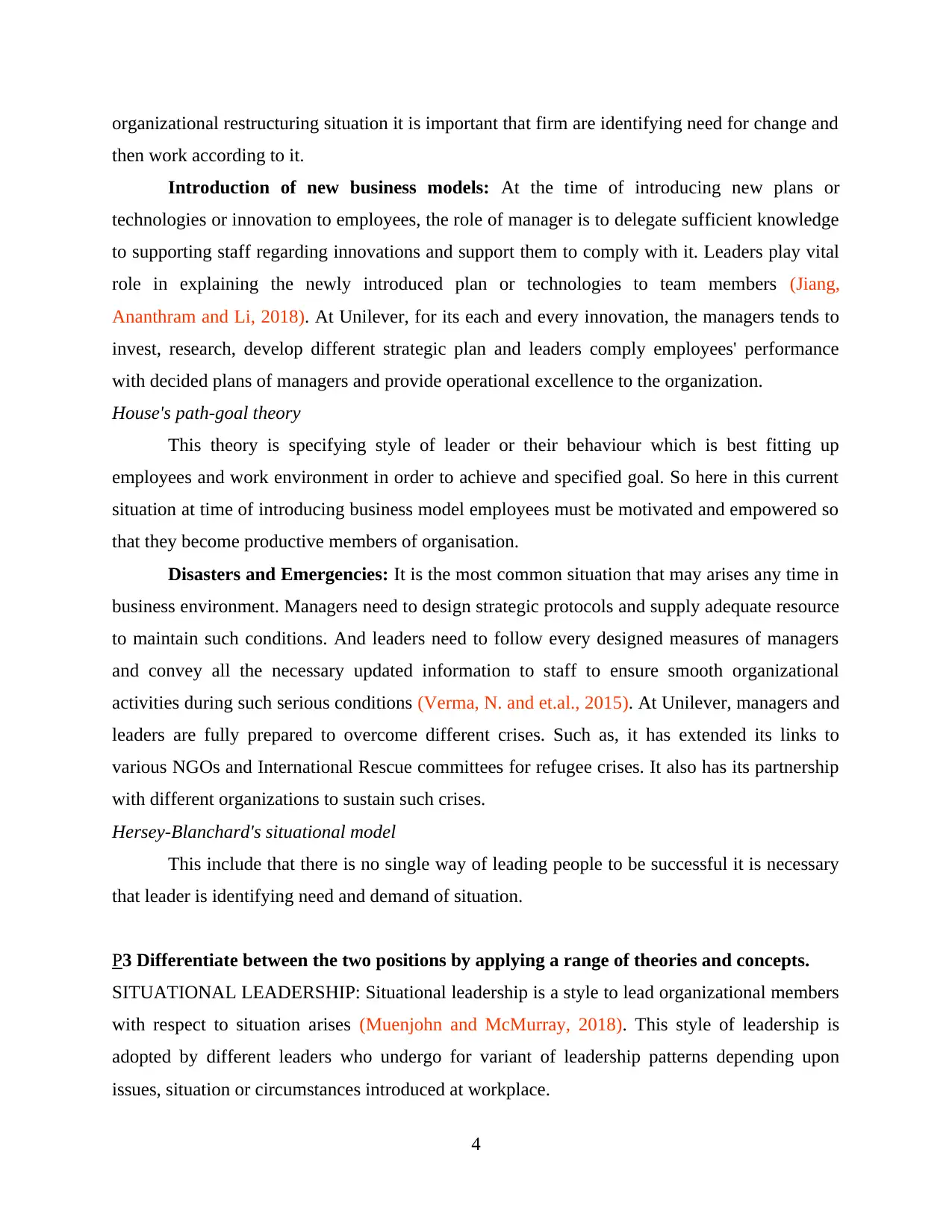
organizational restructuring situation it is important that firm are identifying need for change and
then work according to it.
Introduction of new business models: At the time of introducing new plans or
technologies or innovation to employees, the role of manager is to delegate sufficient knowledge
to supporting staff regarding innovations and support them to comply with it. Leaders play vital
role in explaining the newly introduced plan or technologies to team members (Jiang,
Ananthram and Li, 2018). At Unilever, for its each and every innovation, the managers tends to
invest, research, develop different strategic plan and leaders comply employees' performance
with decided plans of managers and provide operational excellence to the organization.
House's path-goal theory
This theory is specifying style of leader or their behaviour which is best fitting up
employees and work environment in order to achieve and specified goal. So here in this current
situation at time of introducing business model employees must be motivated and empowered so
that they become productive members of organisation.
Disasters and Emergencies: It is the most common situation that may arises any time in
business environment. Managers need to design strategic protocols and supply adequate resource
to maintain such conditions. And leaders need to follow every designed measures of managers
and convey all the necessary updated information to staff to ensure smooth organizational
activities during such serious conditions (Verma, N. and et.al., 2015). At Unilever, managers and
leaders are fully prepared to overcome different crises. Such as, it has extended its links to
various NGOs and International Rescue committees for refugee crises. It also has its partnership
with different organizations to sustain such crises.
Hersey-Blanchard's situational model
This include that there is no single way of leading people to be successful it is necessary
that leader is identifying need and demand of situation.
P3 Differentiate between the two positions by applying a range of theories and concepts.
SITUATIONAL LEADERSHIP: Situational leadership is a style to lead organizational members
with respect to situation arises (Muenjohn and McMurray, 2018). This style of leadership is
adopted by different leaders who undergo for variant of leadership patterns depending upon
issues, situation or circumstances introduced at workplace.
4
then work according to it.
Introduction of new business models: At the time of introducing new plans or
technologies or innovation to employees, the role of manager is to delegate sufficient knowledge
to supporting staff regarding innovations and support them to comply with it. Leaders play vital
role in explaining the newly introduced plan or technologies to team members (Jiang,
Ananthram and Li, 2018). At Unilever, for its each and every innovation, the managers tends to
invest, research, develop different strategic plan and leaders comply employees' performance
with decided plans of managers and provide operational excellence to the organization.
House's path-goal theory
This theory is specifying style of leader or their behaviour which is best fitting up
employees and work environment in order to achieve and specified goal. So here in this current
situation at time of introducing business model employees must be motivated and empowered so
that they become productive members of organisation.
Disasters and Emergencies: It is the most common situation that may arises any time in
business environment. Managers need to design strategic protocols and supply adequate resource
to maintain such conditions. And leaders need to follow every designed measures of managers
and convey all the necessary updated information to staff to ensure smooth organizational
activities during such serious conditions (Verma, N. and et.al., 2015). At Unilever, managers and
leaders are fully prepared to overcome different crises. Such as, it has extended its links to
various NGOs and International Rescue committees for refugee crises. It also has its partnership
with different organizations to sustain such crises.
Hersey-Blanchard's situational model
This include that there is no single way of leading people to be successful it is necessary
that leader is identifying need and demand of situation.
P3 Differentiate between the two positions by applying a range of theories and concepts.
SITUATIONAL LEADERSHIP: Situational leadership is a style to lead organizational members
with respect to situation arises (Muenjohn and McMurray, 2018). This style of leadership is
adopted by different leaders who undergo for variant of leadership patterns depending upon
issues, situation or circumstances introduced at workplace.
4
⊘ This is a preview!⊘
Do you want full access?
Subscribe today to unlock all pages.

Trusted by 1+ million students worldwide
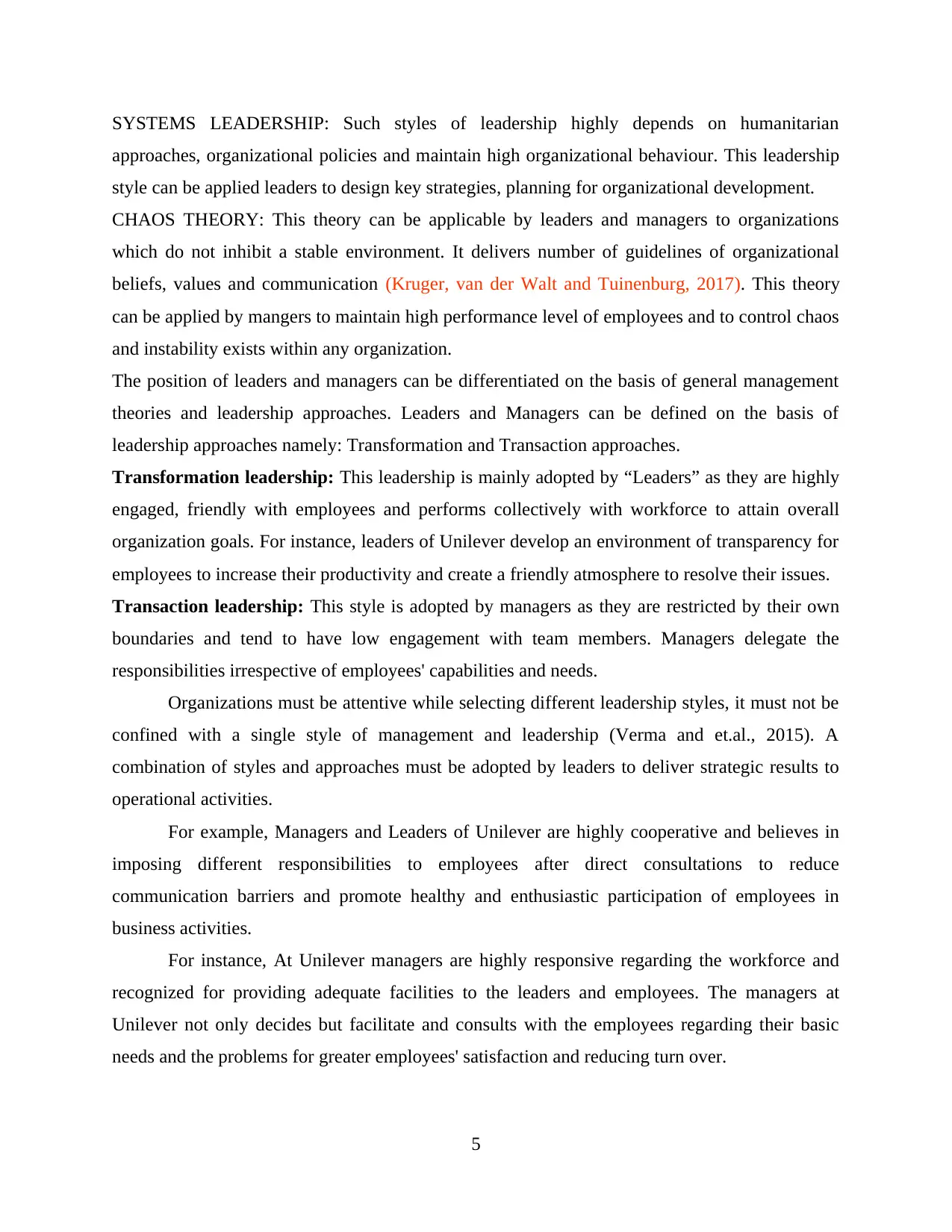
SYSTEMS LEADERSHIP: Such styles of leadership highly depends on humanitarian
approaches, organizational policies and maintain high organizational behaviour. This leadership
style can be applied leaders to design key strategies, planning for organizational development.
CHAOS THEORY: This theory can be applicable by leaders and managers to organizations
which do not inhibit a stable environment. It delivers number of guidelines of organizational
beliefs, values and communication (Kruger, van der Walt and Tuinenburg, 2017). This theory
can be applied by mangers to maintain high performance level of employees and to control chaos
and instability exists within any organization.
The position of leaders and managers can be differentiated on the basis of general management
theories and leadership approaches. Leaders and Managers can be defined on the basis of
leadership approaches namely: Transformation and Transaction approaches.
Transformation leadership: This leadership is mainly adopted by “Leaders” as they are highly
engaged, friendly with employees and performs collectively with workforce to attain overall
organization goals. For instance, leaders of Unilever develop an environment of transparency for
employees to increase their productivity and create a friendly atmosphere to resolve their issues.
Transaction leadership: This style is adopted by managers as they are restricted by their own
boundaries and tend to have low engagement with team members. Managers delegate the
responsibilities irrespective of employees' capabilities and needs.
Organizations must be attentive while selecting different leadership styles, it must not be
confined with a single style of management and leadership (Verma and et.al., 2015). A
combination of styles and approaches must be adopted by leaders to deliver strategic results to
operational activities.
For example, Managers and Leaders of Unilever are highly cooperative and believes in
imposing different responsibilities to employees after direct consultations to reduce
communication barriers and promote healthy and enthusiastic participation of employees in
business activities.
For instance, At Unilever managers are highly responsive regarding the workforce and
recognized for providing adequate facilities to the leaders and employees. The managers at
Unilever not only decides but facilitate and consults with the employees regarding their basic
needs and the problems for greater employees' satisfaction and reducing turn over.
5
approaches, organizational policies and maintain high organizational behaviour. This leadership
style can be applied leaders to design key strategies, planning for organizational development.
CHAOS THEORY: This theory can be applicable by leaders and managers to organizations
which do not inhibit a stable environment. It delivers number of guidelines of organizational
beliefs, values and communication (Kruger, van der Walt and Tuinenburg, 2017). This theory
can be applied by mangers to maintain high performance level of employees and to control chaos
and instability exists within any organization.
The position of leaders and managers can be differentiated on the basis of general management
theories and leadership approaches. Leaders and Managers can be defined on the basis of
leadership approaches namely: Transformation and Transaction approaches.
Transformation leadership: This leadership is mainly adopted by “Leaders” as they are highly
engaged, friendly with employees and performs collectively with workforce to attain overall
organization goals. For instance, leaders of Unilever develop an environment of transparency for
employees to increase their productivity and create a friendly atmosphere to resolve their issues.
Transaction leadership: This style is adopted by managers as they are restricted by their own
boundaries and tend to have low engagement with team members. Managers delegate the
responsibilities irrespective of employees' capabilities and needs.
Organizations must be attentive while selecting different leadership styles, it must not be
confined with a single style of management and leadership (Verma and et.al., 2015). A
combination of styles and approaches must be adopted by leaders to deliver strategic results to
operational activities.
For example, Managers and Leaders of Unilever are highly cooperative and believes in
imposing different responsibilities to employees after direct consultations to reduce
communication barriers and promote healthy and enthusiastic participation of employees in
business activities.
For instance, At Unilever managers are highly responsive regarding the workforce and
recognized for providing adequate facilities to the leaders and employees. The managers at
Unilever not only decides but facilitate and consults with the employees regarding their basic
needs and the problems for greater employees' satisfaction and reducing turn over.
5
Paraphrase This Document
Need a fresh take? Get an instant paraphrase of this document with our AI Paraphraser
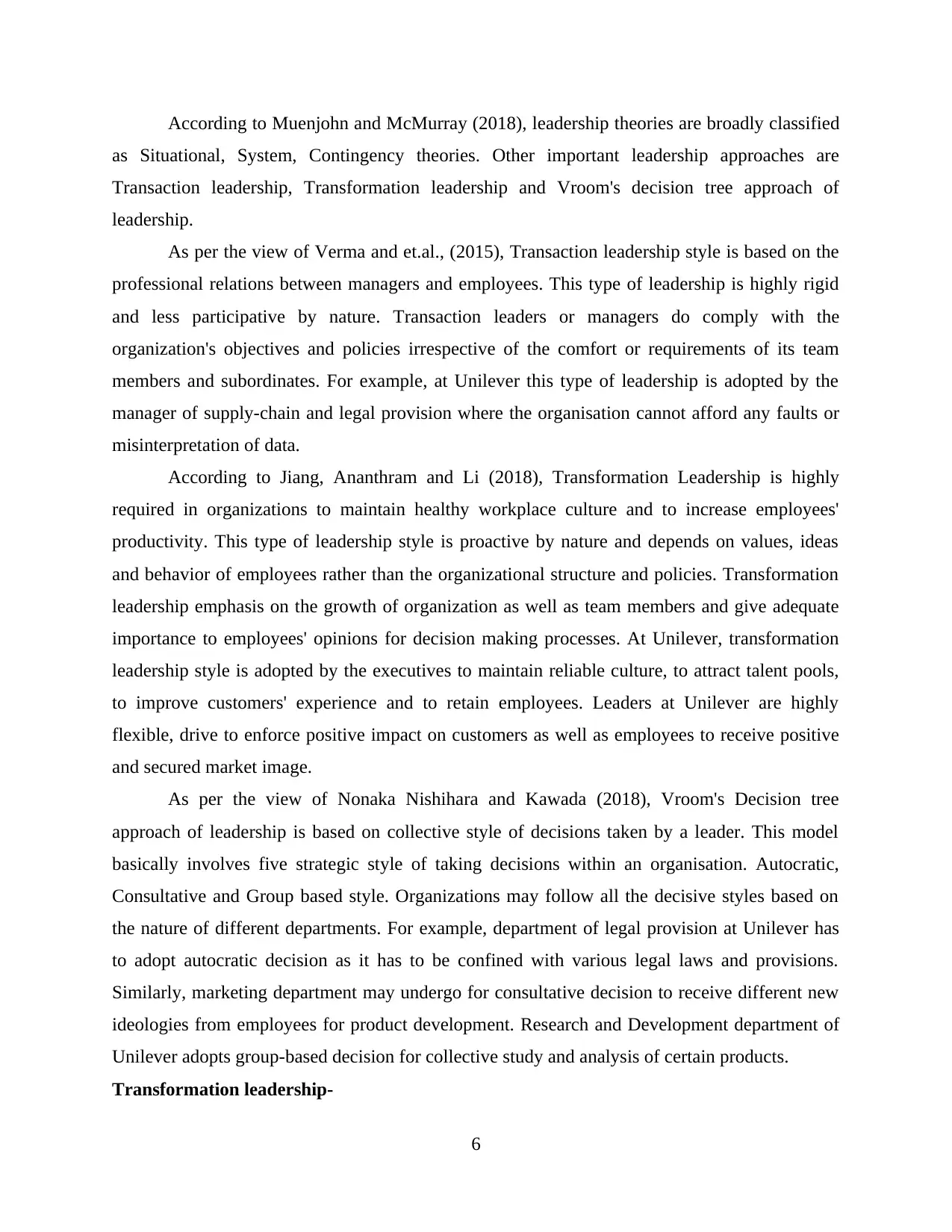
According to Muenjohn and McMurray (2018), leadership theories are broadly classified
as Situational, System, Contingency theories. Other important leadership approaches are
Transaction leadership, Transformation leadership and Vroom's decision tree approach of
leadership.
As per the view of Verma and et.al., (2015), Transaction leadership style is based on the
professional relations between managers and employees. This type of leadership is highly rigid
and less participative by nature. Transaction leaders or managers do comply with the
organization's objectives and policies irrespective of the comfort or requirements of its team
members and subordinates. For example, at Unilever this type of leadership is adopted by the
manager of supply-chain and legal provision where the organisation cannot afford any faults or
misinterpretation of data.
According to Jiang, Ananthram and Li (2018), Transformation Leadership is highly
required in organizations to maintain healthy workplace culture and to increase employees'
productivity. This type of leadership style is proactive by nature and depends on values, ideas
and behavior of employees rather than the organizational structure and policies. Transformation
leadership emphasis on the growth of organization as well as team members and give adequate
importance to employees' opinions for decision making processes. At Unilever, transformation
leadership style is adopted by the executives to maintain reliable culture, to attract talent pools,
to improve customers' experience and to retain employees. Leaders at Unilever are highly
flexible, drive to enforce positive impact on customers as well as employees to receive positive
and secured market image.
As per the view of Nonaka Nishihara and Kawada (2018), Vroom's Decision tree
approach of leadership is based on collective style of decisions taken by a leader. This model
basically involves five strategic style of taking decisions within an organisation. Autocratic,
Consultative and Group based style. Organizations may follow all the decisive styles based on
the nature of different departments. For example, department of legal provision at Unilever has
to adopt autocratic decision as it has to be confined with various legal laws and provisions.
Similarly, marketing department may undergo for consultative decision to receive different new
ideologies from employees for product development. Research and Development department of
Unilever adopts group-based decision for collective study and analysis of certain products.
Transformation leadership-
6
as Situational, System, Contingency theories. Other important leadership approaches are
Transaction leadership, Transformation leadership and Vroom's decision tree approach of
leadership.
As per the view of Verma and et.al., (2015), Transaction leadership style is based on the
professional relations between managers and employees. This type of leadership is highly rigid
and less participative by nature. Transaction leaders or managers do comply with the
organization's objectives and policies irrespective of the comfort or requirements of its team
members and subordinates. For example, at Unilever this type of leadership is adopted by the
manager of supply-chain and legal provision where the organisation cannot afford any faults or
misinterpretation of data.
According to Jiang, Ananthram and Li (2018), Transformation Leadership is highly
required in organizations to maintain healthy workplace culture and to increase employees'
productivity. This type of leadership style is proactive by nature and depends on values, ideas
and behavior of employees rather than the organizational structure and policies. Transformation
leadership emphasis on the growth of organization as well as team members and give adequate
importance to employees' opinions for decision making processes. At Unilever, transformation
leadership style is adopted by the executives to maintain reliable culture, to attract talent pools,
to improve customers' experience and to retain employees. Leaders at Unilever are highly
flexible, drive to enforce positive impact on customers as well as employees to receive positive
and secured market image.
As per the view of Nonaka Nishihara and Kawada (2018), Vroom's Decision tree
approach of leadership is based on collective style of decisions taken by a leader. This model
basically involves five strategic style of taking decisions within an organisation. Autocratic,
Consultative and Group based style. Organizations may follow all the decisive styles based on
the nature of different departments. For example, department of legal provision at Unilever has
to adopt autocratic decision as it has to be confined with various legal laws and provisions.
Similarly, marketing department may undergo for consultative decision to receive different new
ideologies from employees for product development. Research and Development department of
Unilever adopts group-based decision for collective study and analysis of certain products.
Transformation leadership-
6
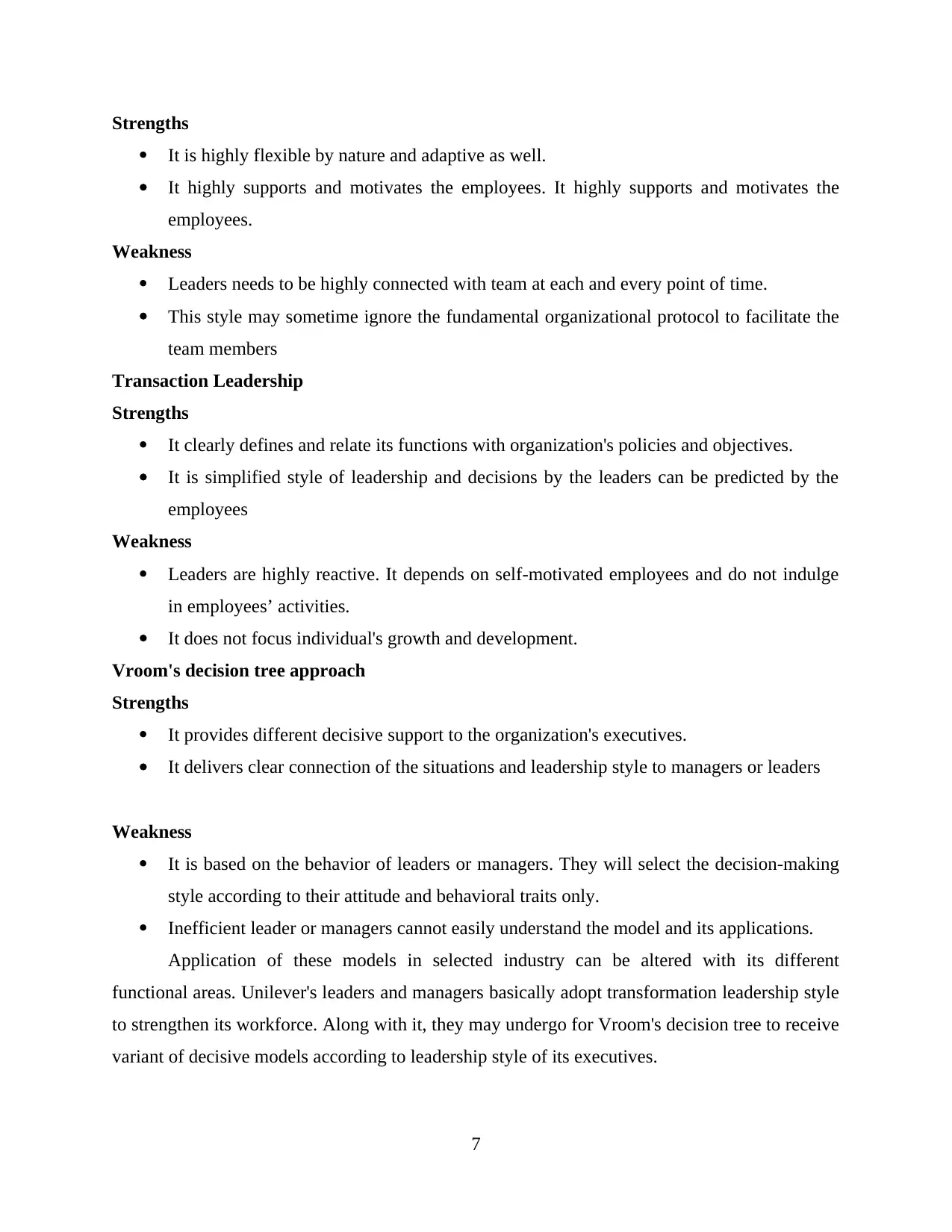
Strengths
It is highly flexible by nature and adaptive as well.
It highly supports and motivates the employees. It highly supports and motivates the
employees.
Weakness
Leaders needs to be highly connected with team at each and every point of time.
This style may sometime ignore the fundamental organizational protocol to facilitate the
team members
Transaction Leadership
Strengths
It clearly defines and relate its functions with organization's policies and objectives.
It is simplified style of leadership and decisions by the leaders can be predicted by the
employees
Weakness
Leaders are highly reactive. It depends on self-motivated employees and do not indulge
in employees’ activities.
It does not focus individual's growth and development.
Vroom's decision tree approach
Strengths
It provides different decisive support to the organization's executives.
It delivers clear connection of the situations and leadership style to managers or leaders
Weakness
It is based on the behavior of leaders or managers. They will select the decision-making
style according to their attitude and behavioral traits only.
Inefficient leader or managers cannot easily understand the model and its applications.
Application of these models in selected industry can be altered with its different
functional areas. Unilever's leaders and managers basically adopt transformation leadership style
to strengthen its workforce. Along with it, they may undergo for Vroom's decision tree to receive
variant of decisive models according to leadership style of its executives.
7
It is highly flexible by nature and adaptive as well.
It highly supports and motivates the employees. It highly supports and motivates the
employees.
Weakness
Leaders needs to be highly connected with team at each and every point of time.
This style may sometime ignore the fundamental organizational protocol to facilitate the
team members
Transaction Leadership
Strengths
It clearly defines and relate its functions with organization's policies and objectives.
It is simplified style of leadership and decisions by the leaders can be predicted by the
employees
Weakness
Leaders are highly reactive. It depends on self-motivated employees and do not indulge
in employees’ activities.
It does not focus individual's growth and development.
Vroom's decision tree approach
Strengths
It provides different decisive support to the organization's executives.
It delivers clear connection of the situations and leadership style to managers or leaders
Weakness
It is based on the behavior of leaders or managers. They will select the decision-making
style according to their attitude and behavioral traits only.
Inefficient leader or managers cannot easily understand the model and its applications.
Application of these models in selected industry can be altered with its different
functional areas. Unilever's leaders and managers basically adopt transformation leadership style
to strengthen its workforce. Along with it, they may undergo for Vroom's decision tree to receive
variant of decisive models according to leadership style of its executives.
7
⊘ This is a preview!⊘
Do you want full access?
Subscribe today to unlock all pages.

Trusted by 1+ million students worldwide
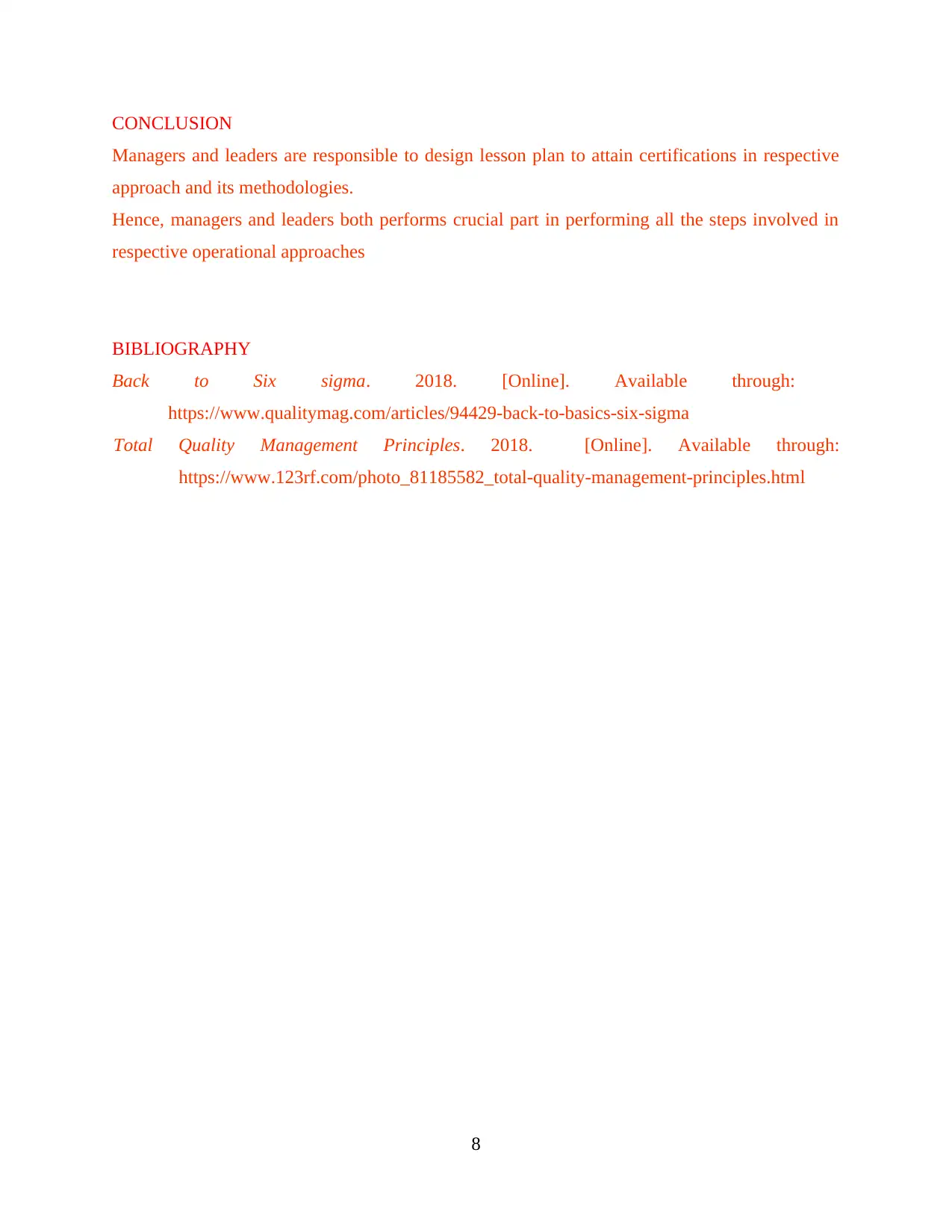
CONCLUSION
Managers and leaders are responsible to design lesson plan to attain certifications in respective
approach and its methodologies.
Hence, managers and leaders both performs crucial part in performing all the steps involved in
respective operational approaches
BIBLIOGRAPHY
Back to Six sigma. 2018. [Online]. Available through:
https://www.qualitymag.com/articles/94429-back-to-basics-six-sigma
Total Quality Management Principles. 2018. [Online]. Available through:
https://www.123rf.com/photo_81185582_total-quality-management-principles.html
8
Managers and leaders are responsible to design lesson plan to attain certifications in respective
approach and its methodologies.
Hence, managers and leaders both performs crucial part in performing all the steps involved in
respective operational approaches
BIBLIOGRAPHY
Back to Six sigma. 2018. [Online]. Available through:
https://www.qualitymag.com/articles/94429-back-to-basics-six-sigma
Total Quality Management Principles. 2018. [Online]. Available through:
https://www.123rf.com/photo_81185582_total-quality-management-principles.html
8
Paraphrase This Document
Need a fresh take? Get an instant paraphrase of this document with our AI Paraphraser
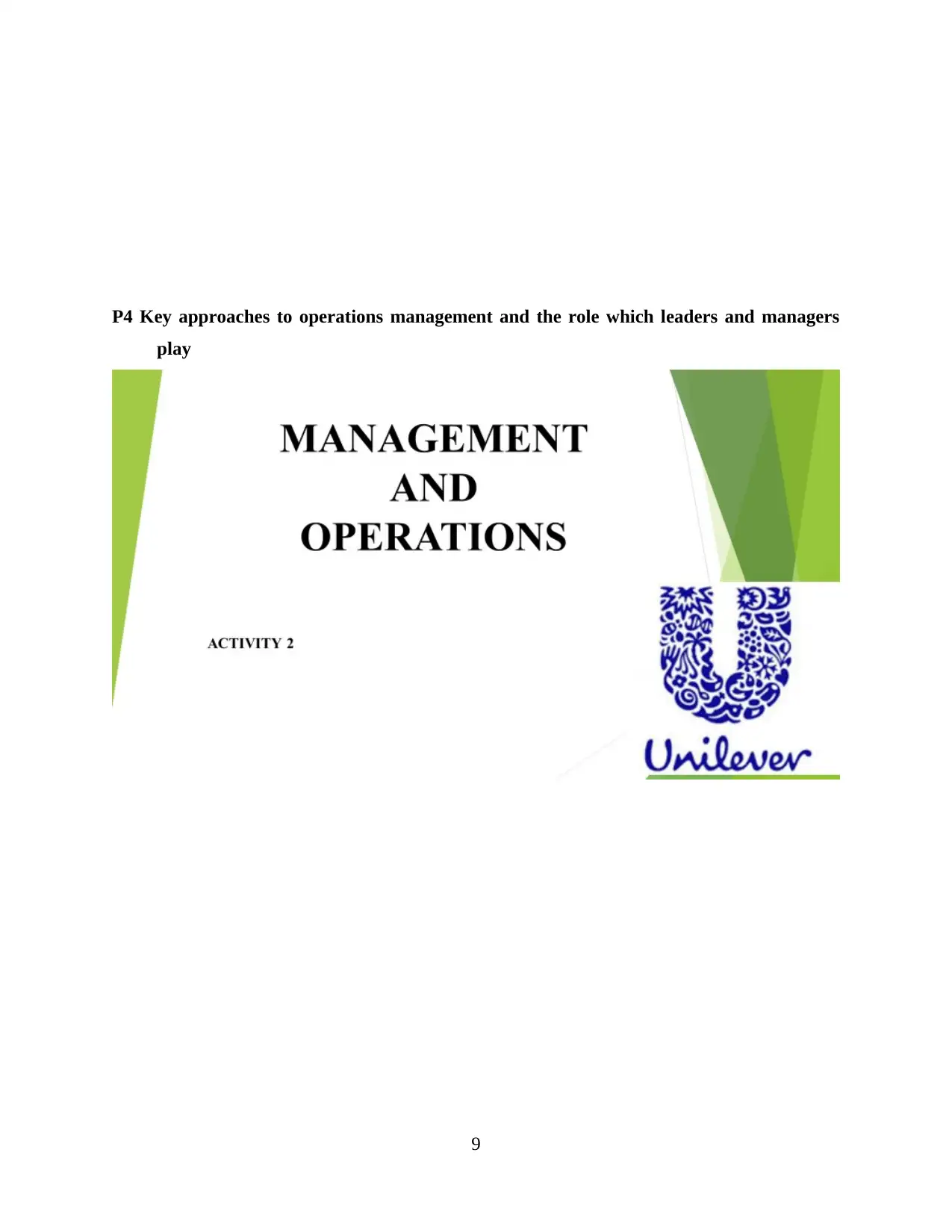
P4 Key approaches to operations management and the role which leaders and managers
play
9
play
9
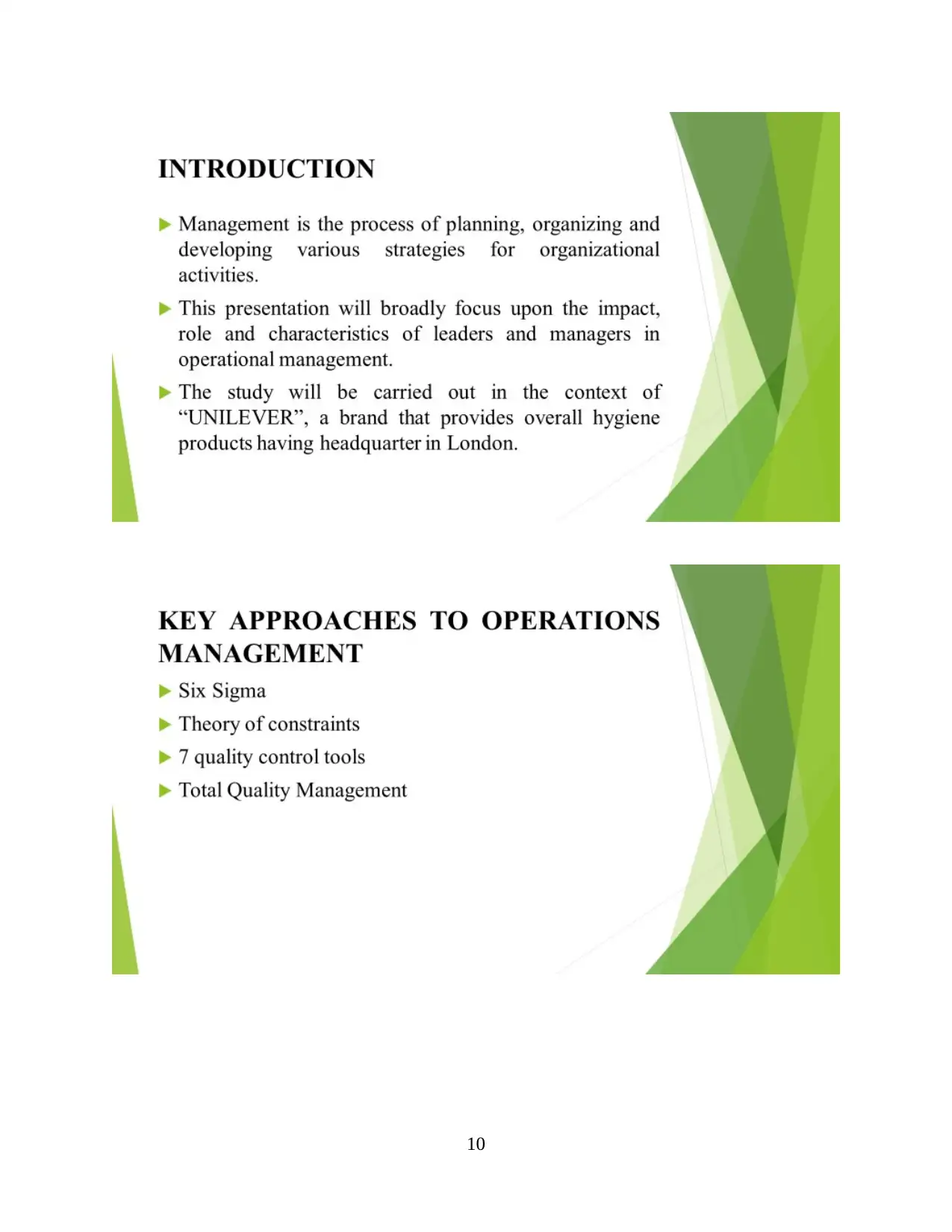
10
⊘ This is a preview!⊘
Do you want full access?
Subscribe today to unlock all pages.

Trusted by 1+ million students worldwide
1 out of 29
Related Documents
Your All-in-One AI-Powered Toolkit for Academic Success.
+13062052269
info@desklib.com
Available 24*7 on WhatsApp / Email
![[object Object]](/_next/static/media/star-bottom.7253800d.svg)
Unlock your academic potential
Copyright © 2020–2025 A2Z Services. All Rights Reserved. Developed and managed by ZUCOL.




